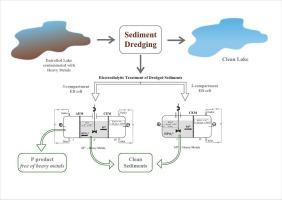电渗析法同时提取分离淡水沉积物中的磷和重金属——沉积物特性的影响
IF 7.1
2区 环境科学与生态学
Q1 ENGINEERING, ENVIRONMENTAL
引用次数: 0
摘要
本文探讨了使用3室和2室电渗析(ED)电池同时从淡水沉积物中提取和分离P和重金属,以回收不含重金属和适合回收的沉积物的P产品。研究使用了来自两种不同淡水来源的富营养化沉积物,一种是重金属污染较少的,另一种是重金属污染严重的。重金属(Cd、Cr、Cu、Ni、Pb、Zn)在高污染沉积物中的萃取量高于低污染沉积物。两种沉积物的ED处理(3室和2室)对Zn的提取率最高(约85%),对Cr的提取率最低(2 - 11%),而P的提取率在35 - 50%之间。相比于2室ED电池,3室ED电池对P和重金属的分离和提取效果更好,这为P萃取液的利用提供了可能。进行顺序提取,以评估在ED处理期间可以提取的可操作定义的P和重金属池。在ED治疗过程中,盐酸可溶性磷被完全提取。可交换组分和可还原组分的重金属被显著提取,而可氧化组分的重金属只被部分提取。经ED处理后,污染较少的沉积物适合回收利用,如:作为土壤改良剂,而不是高污染的沉积物。建议优化ED处理,以提高P和重金属的提取率,特别是从优势和难以调动的氧化部分。本文章由计算机程序翻译,如有差异,请以英文原文为准。

Simultaneous Extraction and Separation of Phosphorus and Heavy Metals from Freshwater Sediments using Electrodialysis – Influence by Sediment Characteristics
This paper explores the use of 3-compartment and 2-compartment electrodialytic (ED) cells for the simultaneous extraction and separation of P and heavy metals from freshwater sediments, to recover a P-product without heavy metals and sediments fit for recycling. Eutrophic sediments from two different freshwater sources, one less contaminated and one highly contaminated with heavy metals, were used. The extraction of heavy metals (Cd, Cr, Cu, Ni, Pb, Zn) was higher from the highly contaminated sediment than from the less contaminated one. The ED treatment (3-compartment and 2-compartment) of both sediments obtained the highest extraction for Zn (about 85 %) and the lowest for Cr (2 – 11%), whereas the extraction of P was between 35 and 50 %. The separation and extraction of P and heavy metals was better with the 3-compartment ED cell than the 2-compartment ED cell, potentially allowing the utilization of the P-extracted solution. Sequential extraction was performed to assess the operationally defined pools of P and heavy metals that could be extracted during the ED treatment. HCl-soluble P was fully extracted during ED treatment. Heavy metals associated with the exchangeable and reducible fractions were extracted significantly, and those with the oxidizable fraction were only partially extracted. After the ED treatment, the less contaminated sediment was suitable for recycling, for eg. as a soil improver, but not the highly contaminated sediment. Optimization of ED treatment is suggested to enhance the extraction of P and heavy metals, especially from the dominant and difficult-to-mobilize oxidizable fraction.
求助全文
通过发布文献求助,成功后即可免费获取论文全文。
去求助
来源期刊

Waste management
环境科学-工程:环境
CiteScore
15.60
自引率
6.20%
发文量
492
审稿时长
39 days
期刊介绍:
Waste Management is devoted to the presentation and discussion of information on solid wastes,it covers the entire lifecycle of solid. wastes.
Scope:
Addresses solid wastes in both industrialized and economically developing countries
Covers various types of solid wastes, including:
Municipal (e.g., residential, institutional, commercial, light industrial)
Agricultural
Special (e.g., C and D, healthcare, household hazardous wastes, sewage sludge)
 求助内容:
求助内容: 应助结果提醒方式:
应助结果提醒方式:


